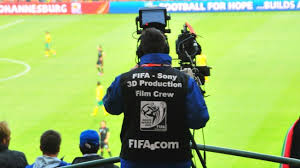By David Owen
March 29 – A 20% jump in income from its Asia and North Africa region enabled FIFA to generate marginally more TV revenue from the 2014 World Cup than the previous edition in South Africa. This was in spite of a near 10% decline in revenue from the key European region.
Analysis by Insideworldfootball of the governing body’s financial reports since 2007 reveals that revenue from television broadcasting rights to Brazil 2014 crept ahead by just 0.9% compared with South Africa 2010 – from $2.405 billion to $2.426 billion.
The advance was attributable to increases from Asia/North Africa and also the Americas and the Caribbean. These offset declines from Europe and the rest of the world. While the hefty 20% Asia/North Africa advance might be considered mildly surprising, the pattern is otherwise as might have been expected, given the differing time-zones in which the two competitions were played.
Revenue from Europe dipped 9.5% from $1.289 billion to $1.167 billion. As a consequence, the traditional heartland of the game fell below the 50% threshold in 2014, contributing 48.1% of overall TV revenue from the Brazilian competition, against 53.6% four years earlier, when the South African time-zone was more readily compatible with peak European viewing hours.
Revenue from Asia/North Africa climbed from $503.5 million for 2010 to $604 million. North America and the Caribbean advanced 16% from $211.1 million to $245.2 million. Meanwhile, revenue from South and Central America rose from $329.3 million to $355.8 million – equivalent to a surprisingly modest 8%, given that this was the 2014 competition’s home region.
The decline in the Rest of the World amounted to a sharp 25% – from $71.7 million to $54 million.
The financial accounts also reveal that FIFA paid marginally less sales commission related to broadcasting rights deals than during the 2010 cycle – $109.9 million, compared with $115.5 million.
FIFA’s six main sponsors – the FIFA Partners – paid the governing body $708.5 million over the four-year Brazil 2014 cycle, up from $594 million over the four preceding years.
This implies that the average sum paid by each of the six – Adidas, Coca-Cola, Hyundai, Emirates, Sony and Visa – rose from $99 million to $118 million. Two of these, Emirates and Sony, are no longer FIFA Partners, while Russia’s Gazprom has joined the remaining quartet for the cycle culminating with the Russia 2018 World Cup.
Contact the writer of this story at moc.l1744473676labto1744473676ofdlr1744473676owedi1744473676sni@n1744473676ewo.d1744473676ivad1744473676

